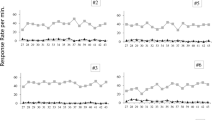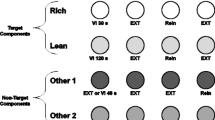Abstract
External discriminative stimuli can modify the behavioral effects of d-amphetamine. Previous work with the pigeon has demonstrated that some aspects of performance on the fixed consecutive number schedule are changed less if a discriminative stimulus indicates when reinforcement is available. This effect has now been replicated with the rat using both simple and multiple schedules. Moderate doses of d-amphetamine (0.56–1.0 mg/kg) usually produced large decreases in reinforced runs when no external cue indicated the possibility of reinforcement. Adding discriminative stimuli when the number requirement was met decreased the drug effect. As was true in the pigeon, response rate measures did not differ between the two stimulus control conditions. Thus, external stimulus control diminishes the drug effect in both species, despite the fact that key pecking was studied in the pigeon and lever pressing in the rat. Evidence was also seen of a possible increase in discriminative stimulus control by d-amphetamine.
Similar content being viewed by others
References
Blough DS (1957) Some effects of drugs on visual discrimination in the pigeon. Ann NY Acad Sci 66:733–739
Ferster CB, Skinner BF (1957) Schedules of reinforcement. Appleton Century Crofts, New York
Frontali M, Amorico L, DeAcetis L, Bignami G (1976) A pharmacological analysis of processes underlying differential responding: A review and further experiments with scopolamine, amphetamine, lysergic acid diethylamide (LSD-25), chlordiazepoxide, physostigmine, and chlorpromazine. Behav Biol 18:1–74
Hill RT (1970) Facilitation of conditioned reinforcement as a mechanism of psychomotor stimulation. In: Costa E, Garattini S (eds) Amphetamines and related compounds. Raven, New York, pp 781–795
Laties VG (1972) The modification of drug effects on behavior by external discriminative stimuli. J Pharmacol Exp Ther 183:1–12
Laties VG (1975) The role of discriminative stimuli in modulating drug action. Fed Proc 34:1880–1888
Mechner F (1958) Probability relations within response sequences under ratio reinforcement. J Exp Anal Behav 1:109–121
Peters DAV, Anisman H, Pappas BA (1978) Monoamines and aversively motivated behaviors. In: Anisman H, Bignami G (eds) Psychopharmacology of aversively motivated behavior, Plenum, New York, pp 257–343
Robbins TW (1975) The potentiation of conditioned reinforcement by psychomotor stimulant drugs. A test of Hill's hypothesis. Psychopharmacologia 45:103–114
Robbins TW (1978) The acquisition of responding with conditioned reinforcement: Effects of pipradrol, methylphenidate, d-amphetamine, and nomifensine. Psychopharmacology 58:79–87
Scheuer C, Moore JN (1974) Breakdown of stimulus control by d-amphetamine. Physiol Psychol 2:427–430
Thompson DM (1978) Stimulus control and drug effects. In: Blackman DE, Sanger DJ (eds) Contemporary research in behavioral pharmacology. Plenum, New York, pp 159–207
Wagman WD, Maxey GC (1969) The effects of scopolamine hydrobromide and methyl scopolamine hydrobromide upon the discrimination of interoceptive and exteroceptive stimuli. Psychopharmacologia 15:280–288
Author information
Authors and Affiliations
Rights and permissions
About this article
Cite this article
Laties, V.G., Wood, R.W. & Cooper Rees, D. Stimulus control and the effects of d-amphetamine in the rat. Psychopharmacology 75, 277–282 (1981). https://doi.org/10.1007/BF00432438
Received:
Accepted:
Issue Date:
DOI: https://doi.org/10.1007/BF00432438




